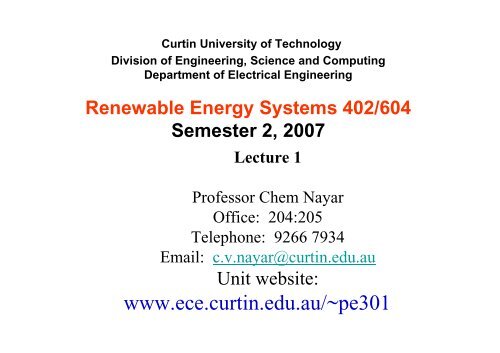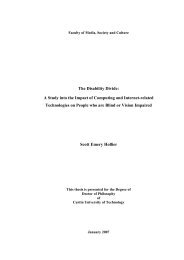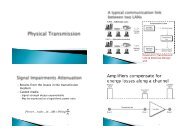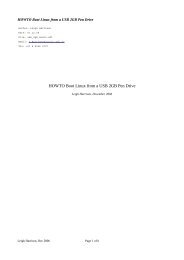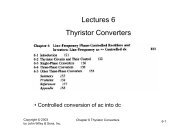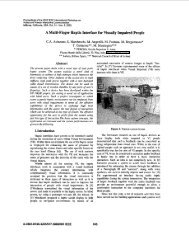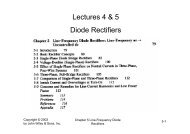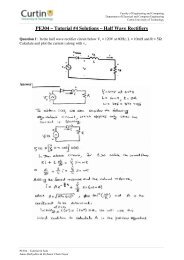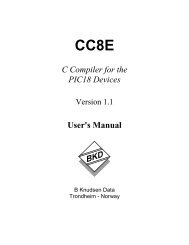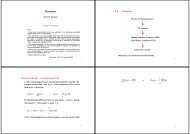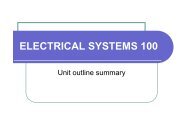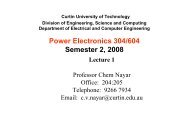Overview Renewable Energy Systems 402 .pdf - Curtin University
Overview Renewable Energy Systems 402 .pdf - Curtin University
Overview Renewable Energy Systems 402 .pdf - Curtin University
Create successful ePaper yourself
Turn your PDF publications into a flip-book with our unique Google optimized e-Paper software.
<strong>Curtin</strong> <strong>University</strong> of Technology<br />
Division of Engineering, Science and Computing<br />
Department of Electrical Engineering<br />
<strong>Renewable</strong> <strong>Energy</strong> <strong>Systems</strong> <strong>402</strong>/604<br />
Semester 2, 2007<br />
Lecture 1<br />
Professor Chem Nayar<br />
Office: 204:205<br />
Telephone: 9266 7934<br />
Email: c.v.nayar@curtin.edu.au<br />
Unit website:<br />
www.ece.curtin.edu.au/~pe301
<strong>Renewable</strong> <strong>Energy</strong> <strong>Systems</strong><br />
<strong>402</strong>/604<br />
Tuition Pattern:<br />
5 Hours:<br />
Lecture 2.00 hours, 1.00 weekly<br />
Tutorial 1.00 hour, 1.00 weekly<br />
Laboratory 2.00 hours fortnightly<br />
Assessment Details:<br />
Assignments : 4 0%<br />
Assignment – 1 (20%)<br />
Assignment - 2 (20%)<br />
Final Examination (2hours) : 60%<br />
Closed book , restricted exam.<br />
( Students can bring a single page of A4 size notes handwritten or typed on<br />
both sides and calculators)
Recommended Texts and Principal References<br />
1. H. L. Willis and W.G. Scott, “Distributed Power Generation, Marcel<br />
Dekker Inc., 2000<br />
1. G. Boyle, “<strong>Renewable</strong> <strong>Energy</strong>, power for sustainable future”, Oxford,<br />
2004.<br />
2. J.F. Manwell, et al, “Wind <strong>Energy</strong> Explained”, John Wiley and Sons,<br />
2002.<br />
3. S. Wenham, M. Green and M. Watt, “Applied Photovoltaics, UNSW,<br />
ISBN 0 86758 909 4.<br />
2.S. AustraliaTM, "AS 4777.3: Grid connections of energy systems via<br />
inverters Part 3: Grid protection requirements," in Standards AustraliaTM,<br />
2002.<br />
3.S. AustraliaTM, "AS 4777.1: Grid connections of energy systems via<br />
inverters Part 1: Installation requirements," in Standards AustraliaTM, 2002.<br />
4.S. AustraliaTM, "AS 4777.2: Grid connections of energy systems via<br />
inverters Part 2: Inverter requirements," in Standards AustraliaTM, 2002.
<strong>Renewable</strong> <strong>Energy</strong> <strong>Systems</strong> <strong>402</strong> Semester 2, 2007<br />
Week Day Topics Lecturer Duration Pre-readings Tutorial Assignment Due<br />
1 31-Jul Introduction Prof. Nayar 4-6pm Lecture Notes<br />
2 7-Aug PV <strong>Systems</strong> 1 M. Dymond 4-6pm Lecture Notes Tutorial No.1<br />
3 14-Aug PV <strong>Systems</strong> 2 M. Dymond 4-6pm Lecture Notes Tutorial No.2<br />
4 21-Aug Wind <strong>Energy</strong> <strong>Systems</strong> 1 Prof Nayar 4-6pm Lecture Notes Tutorial No.3<br />
5 4-Sep Wind <strong>Energy</strong> <strong>Systems</strong> 2 Prof. Nayar 4-6pm Lecture Notes Tutorial No.4<br />
6 11-Sep Wind <strong>Energy</strong> <strong>Systems</strong> 3 Prof. Nayar 4-6pm Lecture Notes Tutorial No.5<br />
7 18-Sep <strong>Energy</strong> Economics Prof. Nayar 4-6pm Lecture Notes Tutorial No.6<br />
8 2-Oct Small Hydro <strong>Systems</strong> Dr. Sumedha 4-6pm Lecture Notes Tutorial No.7 Assignment No.1<br />
9 9-Oct Fuell Cells 1 Dr. Sumedha 4-6pm Lecture Notes Tutorial No.8<br />
10 16-Oct Fuell Cells 2 Dr. Sumedha 4-6pm Lecture Notes Tutorial No.9<br />
11 23-Oct Distributed Generation 1 Dr. Sumedha 4-6pm Lecture Notes Tutorial No.10<br />
12 30-Oct Distributed Generation 2 Dr. Sumedha 4-6pm Lecture Notes<br />
13 6-Nov Study week Assignment No.2
<strong>Renewable</strong> <strong>Energy</strong> <strong>Systems</strong> <strong>402</strong>/604 Lab
<strong>Overview</strong> of <strong>Renewable</strong><br />
<strong>Energy</strong> <strong>Systems</strong>, Distributed<br />
Generation
What Are Distributed Generators?<br />
• Distributed generation (DG) systems are small<br />
modular electric power generation units<br />
(
DG – A Future Mode of Generation<br />
• Central generation stations vs DG systems (now)<br />
• Super computers vs Personal Computers (25 years ago)
Tremendous DG Market Potential<br />
• Global electricity consumption:40% of total global energy consumption<br />
• Present global DG capacity:30 GW installed capacity<br />
• DG growth rate:currently 8-9GW/year or 3% of newly installed<br />
generation capacity; will be 6% of newly installed capacity by 2020<br />
Global new-capacity Global new DG capacity
Capacity (GW)<br />
Rapid DG Growth – Wind Capacity<br />
80<br />
70<br />
60<br />
50<br />
40<br />
30<br />
20<br />
10<br />
0<br />
Cumulative Capacity<br />
Installed Capacity<br />
90 91 92 93 94 95 96 97 98 99 00 01 02 03 04 05 06<br />
Year
Rapid DG Growth – PV Capacity
Driving Forces for Rapid DG Growth<br />
Deregulation and<br />
Economics:<br />
Trade<br />
Investment<br />
Environmental<br />
Concerns:<br />
GHG reduction<br />
<strong>Energy</strong> efficiency<br />
Electricity<br />
Sector<br />
Technological<br />
Innovation<br />
Demands:<br />
Increasing demand<br />
Supply quality<br />
Supply security
Electricity and GHG Emissions<br />
Coa l 34. 1%<br />
Courtesy of Hydro Quebec<br />
Nuc l ear 17. 0%<br />
Nat ual Gas 18 . 8%<br />
Oi l 9. 9%<br />
Ren ewabl es 20 . 2%<br />
Electricity: 0.51kg/kWh, or 20% of global GHG
Increasing Electricity Demand<br />
Annual World Electricity Consumption Will Increase at 2.3%<br />
(Developing Countries at 3.5%)<br />
Electricity Consumption (TWh)<br />
25000<br />
20000<br />
15000<br />
10000<br />
5000<br />
0<br />
EE/FSU<br />
Developing<br />
Industrialized<br />
North America<br />
2001 2010 2015 2020 2025<br />
Year
<strong>Energy</strong> Security: Oil and Gas Will<br />
Deplete, Sooner or Later
A Direct Drive Wind Turbine
A Wind Turbine System –<br />
Kinetic ⇒Mechanical ⇒Electric <strong>Energy</strong><br />
• Turbine input power<br />
Pwind =<br />
1 1<br />
mu = ρ Au<br />
2 2<br />
2 3<br />
• Turbine output power<br />
Pmech =<br />
1<br />
2<br />
3<br />
Au Cp ρ<br />
• Turbine performance factor Cp. Theoretical<br />
maximum Cp: Cpmax=16/27=0.593,<br />
practical maximum Cp=0.4 - 0.5
Photovoltaic Cells<br />
• Solar cell operation is based on the ability of<br />
semiconductors to convert sunlight directly into<br />
electricity. In the conversion process the incident energy<br />
of light creates mobile charged particles in the<br />
semiconductor, which are then separated by the device<br />
structure and produce electrical current.
Characteristics of PV Cells<br />
6<br />
5<br />
4<br />
3<br />
2<br />
1<br />
0<br />
1000W/m 2<br />
800W/m 2<br />
600W/m 2<br />
0 5 10 15 20 25
6<br />
5<br />
4.6<br />
Current (A)<br />
4<br />
3<br />
2<br />
1<br />
0<br />
VI Characteristic Curve<br />
Nominal 12V array<br />
0 5 10 15 20 25<br />
Voltage (V)<br />
17.4<br />
120<br />
100<br />
80<br />
60<br />
40<br />
20<br />
0<br />
79<br />
Power(W)
Effect of Solar Radiation Level<br />
6<br />
5<br />
4<br />
3<br />
2<br />
1<br />
0<br />
1000W/m 2<br />
800W/m 2<br />
600W/m 2<br />
0 5 10 15 20 25
6<br />
5<br />
4<br />
3<br />
2<br />
1<br />
0<br />
Effect of Temperature<br />
75C<br />
50C<br />
25C<br />
0 5 10 15 20 25<br />
This characteristic is important in determining the dc voltage window<br />
of grid connected inverters<br />
0C
Photovoltaic Power <strong>Systems</strong><br />
(a)<br />
DC Input<br />
Power<br />
Electronics<br />
Interface<br />
(b)<br />
Utility
Wind Electric <strong>Systems</strong><br />
Generator<br />
and<br />
Power Electronics<br />
Utility
Power Electronic Converters:<br />
Enabling Technology for DG <strong>Systems</strong><br />
Converters in components, functions and systems of distributed generators
Functions of Power Electronic<br />
Converters for DG <strong>Systems</strong><br />
• Power Conversion<br />
– ac-dc, dc-ac, ac-ac, dc-dc; voltage and<br />
frequency control<br />
• Interconnection with Grid & System Protection<br />
– meeting requirements of interconnection standards<br />
• Resource Control (optimize sources and loads)<br />
– maximum power point tracking<br />
• Power System Support<br />
– power and reactive power control, dispatch etc.
Bidirectional Switching Power Pole<br />
Ref: Mohan
Low Frequency PWM Generation<br />
Ref: Mohan<br />
V<br />
d a =<br />
V<br />
aN<br />
d
Single-Phase Inverter<br />
Ref: Mohan<br />
v =<br />
Vˆ<br />
o sin<br />
w<br />
o 1<br />
t
Single Phase Grid Connected Inverter
Three-Phase Inverter-Sine PWM<br />
3<br />
( Vl ) V<br />
l max =<br />
d ~ 0.<br />
867V<br />
2<br />
d
Three-Phase Inverter- Sine PWM
Current Source/Voltage Inverter<br />
• A current source inverter (CSI)<br />
has an inductor in series with<br />
the DC input<br />
• A voltage source inverter (VSI)<br />
has a capacitor across the DC<br />
input<br />
– Voltage controlled VSI (VCVSI)<br />
– Current controlled VSI (CCVSI)<br />
Idc<br />
Vdc<br />
L<br />
Q1<br />
Q2<br />
Q1<br />
C<br />
Q2<br />
Io<br />
Io<br />
Load<br />
Load<br />
Q4<br />
Q3<br />
Q4<br />
Q3
Voltage Controlled VSI<br />
P<br />
g<br />
VgVc<br />
VgVc<br />
V<br />
= sin δ;<br />
Qg<br />
= cosδ<br />
−<br />
X<br />
X X<br />
L<br />
L<br />
2<br />
g<br />
L
Current Controlled VSI<br />
ϕ<br />
Real power and Reactive power can<br />
be controlled by regulating the magnitude,<br />
and the angle φ<br />
φ<br />
P g = Vg<br />
I g cosφ; Qg<br />
= Vg<br />
I g sinϕ<br />
I =<br />
Pg= VIg cosφ Qg= VIg sinφ<br />
L<br />
I<br />
g
Current Controlled VSI<br />
• Fast current response<br />
• Inherent current protection<br />
• Appropriate for gridconnected<br />
inverters such<br />
as for PV/Wind generators<br />
– Hysteresis current<br />
controller<br />
– Ramp controller<br />
– Predictive controller<br />
– Current-based space vector<br />
controller
Hysteresis Current Controller
Active and Reactive Power Control
PV/Grid <strong>Energy</strong> System Configurations<br />
• Large Single Inverter Type (Central<br />
Inverter)<br />
• Multiple Small Inverter Type (String<br />
Inverter)<br />
• DC Bus (Multi-string Inverter)<br />
• “AC” Module
Large Single Inverter Type<br />
• Series and Parallel<br />
connection on DC<br />
side<br />
• All PV panels<br />
connected to single<br />
DC bus<br />
• Single Central<br />
Inverter<br />
• Affected by partial<br />
shading of panels<br />
• Only one protection<br />
system required
Multiple Small Inverter Type<br />
• One inverter per<br />
string<br />
• Panels grouped into<br />
smaller inverter –<br />
rated power of<br />
Inverter ( 0.7-5kW)<br />
• Not so badly<br />
affected by shading<br />
• Not badly affected<br />
by inverter failure
Grid-Connected PV Inverter (String Type)<br />
@ 3.3kW
Grid-Connected with <strong>Energy</strong> Back up System<br />
AC Line<br />
DC from PV<br />
160 to 240 V<br />
AC Grid Line<br />
DC 48 V<br />
Controller Back up Line<br />
AC Line<br />
DC 48 V
Grid-Connected PV System<br />
with Back up Inverter<br />
Kang Som-Mao, Ratchaburi<br />
75 Wp x 42 modules<br />
PV<br />
CONTROLLER -<br />
BATTERY batteries for S-218C<br />
INVERTER APOLLO G –304 And S-218C
• Each panel or<br />
group have a DC-<br />
DC step up<br />
converter<br />
• High voltage DC<br />
link feeds<br />
transformer-less<br />
converter<br />
DC Linked
• One Inverter per<br />
panel<br />
• High volume/<br />
low cost?<br />
• Plug-and-play?<br />
AC Modules
Wind<br />
Wind <strong>Energy</strong> Conversion System<br />
Mechanical Power Electrical Power<br />
Wind Turbine<br />
Rotor<br />
Gearbox/<br />
Transmission<br />
Generator<br />
Power<br />
Converter<br />
Power<br />
Transformer<br />
Electric Grid
Permanent Magnet PM Generator<br />
GB<br />
L DC<br />
C DC<br />
V DC<br />
L AC
Applications of Single-Phase<br />
Inverters for Small Wind Turbines<br />
Wind turbine system
AC/DC/AC Full Power Converter<br />
for Three-Phase Grids (PWM Rectifier)
Micro Hydro
Fuel Cells<br />
• Fundamentals<br />
and<br />
background<br />
• <strong>Energy</strong><br />
Conversion<br />
Principle
Microgrid<br />
• A MicroGrid power system<br />
– Is a local scale power system using distributed resources scaled to<br />
the local system demand.<br />
– Is designed to transfer seamlessly between connection with the<br />
local utility and isolated operation.<br />
• Benefits<br />
– Improved power reliability and power quality<br />
– Potential economic benefits: CHP, higher efficiency, diversified fuel<br />
supplies<br />
– Possible ancillary services for power system operators<br />
– Transmission and distribution support in constrained areas.<br />
– Potential for reduced emissions compared to centralized utility.<br />
– Ability to allow high penetration of renewable generation.
Case study : The Republic of Maldives<br />
1,192 islands<br />
with a land area of<br />
about 300 km2,<br />
formed on a chain<br />
of 26 coral reef<br />
atolls in the Indian<br />
Ocean<br />
80 percent of<br />
the total landmass<br />
of the Maldives is<br />
less than 1 meter<br />
above sea level
Kondey<br />
Maldives Remote Islands<br />
Uligam<br />
Raimandhoo
Advantages of the <strong>Renewable</strong> <strong>Energy</strong><br />
Micro-Grid System<br />
+ + +<br />
POWER<br />
ELECTRONICS<br />
• Can Provide 24 hours of Electricity<br />
• Diesel Generator operating hours will be reduced which leads<br />
to save in fuel plus O&M cost<br />
• Reduced Cost of Electricity<br />
• Fast pay back period [2-3 Years]<br />
• Reduced noise and air pollution<br />
• Reduced Greenhouse Gas Emission<br />
+
Micro Grid for Uligam lsland
Micro Wind Farm


